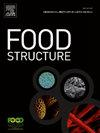不同温度冻融循环对未发酵面团面筋蛋白性质的影响
IF 5.6
3区 农林科学
Q1 FOOD SCIENCE & TECHNOLOGY
引用次数: 1
摘要
研究了不同温度(-6°C、-12°C、-18°C、-24°C和-30°C)下的冻融循环(1-5个循环)对从面团中分离的面筋性能的影响。结果表明,经过相同次数的冻融循环后,面筋蛋白在较低温度下的持水能力较高,粘弹性和结合水含量随温度的降低略有增加。与其他温度条件相比,在-30°C和-24°C下,面筋蛋白的微观结构更加均匀且相对完整。较低的温度导致α-螺旋和β-转弯的比例显著降低,β-片的比例显著增加。在相同温度下,随着冻融循环次数的增加,保水能力、结合水含量和粘弹性均下降。与第一次冻融循环(F1)相比,第五次冻融周期(F5)的面筋微观结构中的空洞更大,甚至出现断裂。简而言之,冻融循环次数的增加损害了面筋蛋白的性质,而较低的温度更有利于保持面筋性质的稳定性。本文章由计算机程序翻译,如有差异,请以英文原文为准。
Effect of Freeze-Thaw Cycles at Different Temperatures on the Properties of Gluten Proteins in Unfermented Dough
The effects of freeze-thaw cycles (from 1 to 5 cycles) at different temperatures (-6 °C, -12 °C, -18 °C, -24 °C, and -30 °C) on the properties of gluten isolated from dough were investigated. The results showed that after the same number of freeze-thaw cycle, the water-holding capacity of gluten protein was higher at lower temperatures, and the viscoelasticity and bound water content increased slightly with decreasing temperature. The microstructure of gluten protein was more uniform and relatively complete at -30 °C and -24 °C compared with other temperature conditions. Lower temperatures led to a significant decrease in the proportion of α-helices and β-turns and a notable increase in that of β-sheets. At the same temperature, the water-holding capacity, bound water content and viscoelasticity decreased with increasing number of freeze-thaw cycles. Compared with the first freeze-thaw cycle (F1), the cavity in the gluten microstructure of the fifth freeze-thaw cycle (F5) was larger and even exhibited fracture. In short, the increase in the number of freeze-thaw cycles damages the properties of gluten protein, and lower temperatures are more conducive to maintaining the stability of gluten properties.
求助全文
通过发布文献求助,成功后即可免费获取论文全文。
去求助
来源期刊

Food Structure-Netherlands
Chemical Engineering-Bioengineering
CiteScore
7.20
自引率
0.00%
发文量
48
期刊介绍:
Food Structure is the premier international forum devoted to the publication of high-quality original research on food structure. The focus of this journal is on food structure in the context of its relationship with molecular composition, processing and macroscopic properties (e.g., shelf stability, sensory properties, etc.). Manuscripts that only report qualitative findings and micrographs and that lack sound hypothesis-driven, quantitative structure-function research are not accepted. Significance of the research findings for the food science community and/or industry must also be highlighted.
 求助内容:
求助内容: 应助结果提醒方式:
应助结果提醒方式:


